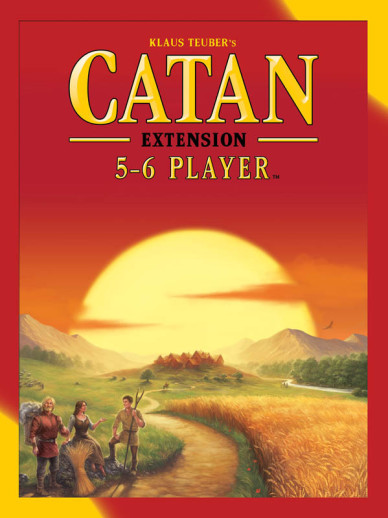We use cookies to make your experience better. To comply with the new e-Privacy directive, we need to ask for your consent to set the cookies. Learn more.
Settlers of Catan 5-6 Player Expansion
- Small parts. Not for children under 3 years.
Includes all extension materials to allow two additional players. Updated with new artwork.
You can settle Catan with up to 6 players.
If you want to play the Catan base gamewith 5 or 6 players, just add this base game extension.
My husband and I are avid game players, and we cannot recommend this game too highly! We were fortunate to meet friends that introduced Settlers of Catan to us last fall, and since then we have gotten many family members and friends hooked as well. While some games (such as Chess) depend solely on strategy and may intimidate some, and others revolve completely around luck which may not be engaging enough for others, Settlers of Catan is the perfect blend of strategy and luck, making it appealing to almost everyone. Strategy is indeed important, although not at such an intense level as in Chess or Risk, yet the roll of the die can cause even the most astute plan to fall short, or likewise, it can bolster a position that is seemingly inferior. What really makes this game stand out is that the unique construction of the game board generates a different board every time you play, which keeps the game fresh and causes you to think through your strategy differently each game. The basis of the game is that you represent a group of settlers trying to establish yourself on the distant isle of Catan. To this end, you have to produce resources with which you can continue developing. The board consists of 19 hexagonal tiles which fit randomly into a larger hexagonal frame depicting the sea. Each of the 19 tiles represents a resource - lumber, brick, ore, grain, or wool - with the exception of one desert tile. After fitting the tiles into the frame, small number tokens are placed on each tile, with numbers ranging from 2-12 (these being the numbers which can be rolled with two dice). Each player has a set of colored wooden settlements, roads, and cities to use in developing Catan. The game begins with an initial settlement phase, where each player gets to place two settlements on the board. These are placed on the corners of the resource hexagons, so that each settlement sits on an intersection of three different resource hexagons. Players also attach one road to their settlement, which can branch out along any path between tiles. When each player has finished placing their initial settlements, regular play begins. The typical turn consists of three different "phases," although players may not always choose to do all three. Firstly, a player begins by rolling the two dice. The number rolled determines which resource hexagons produce resources for that turn. For instance, if you roll an 8, any player that has a settlement adjacent to a resource hexagon marked with an "8" receives a resource card of that type. Thus even when it is not your turn, you are collecting resource cards. After rolling the die and gathering any resources produced, the player whose turn it is may trade with other players or with the bank. This allows a good trader to acquire the resources that may be eluding him, whether due to position or the roll of the die. The final phase of each player's turn is the building phase. At this point, a player may use the resource cards in his hand to build any roads, settlements or cities he chooses, as well as buy development cards. Each of these four items requires a different combination of resources. For instance, building a road costs one lumber and one brick resource card. The object of the game is to be the first player to reach 10 points. Each settlement on the board is worth one point, and each city is worth two. Additional points are available for those with the longest road or largest army, as well as through certain development cards. Though the above is the "basic" game play, you will quickly see that there is more to the game. Different development cards can prove advantageous to the holder and detrimental to others; the robber could rob you of needed resources, and building on a harbor can provide you a more favorable exchange rate for trading. There are many different routes to victory, and those who conquer them will successfully settle the isle of Catan. 3-4 players. There are expansions sets available below, but please note that they do not stand alone - you will need to already have the original Settlers of Catan board game.
Expansion sets require the original Settlers of Catan game to play.
| Product Format: | Other |
|---|---|
| Brand: | Mayfair Games |
| Grades: | 5-AD |
| EAN/UPC: | 029877030729 |
| Length in Inches: | 8.5 |
| Width in Inches: | 6.375 |
| Height in Inches: | 1.8125 |
| Weight in Pounds: | 1.1 |

